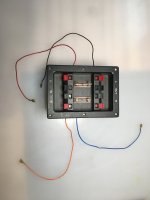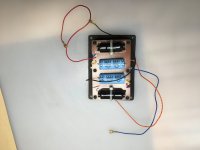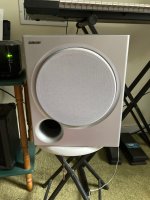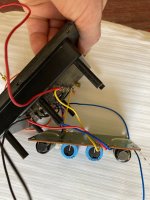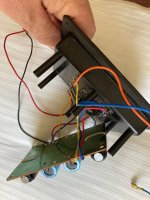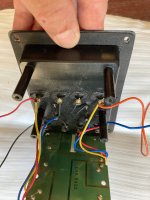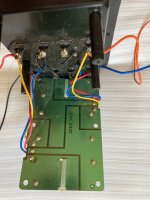I have what I believe is a subwoofer crossover (?) and would like to know if I can convert a Sony subwoofer (made for computer use) to an all-purpose sub using the crossover unit (see pics). As I said, I'm a novice so my knowledge is quite limited as far as the technicalities are concerned. This is just a hobby project I thought I'd try my hand at.
Attachments
Passive XOs are very specific to the driver/box used, and subwoofer passive XOs are extremely problematic.
Try it, unlikely to work well.
dave
Try it, unlikely to work well.
dave
That seems for a double voice coil woofer, something like old Canton subwoofers ( or similar). Both channels are applied to a single piston.
The capacitors in the center are for signal high-pass function, the coils make a low pass. You can desolder all of them ( fuses holders are nice!) and use them for future projects.
The capacitors in the center are for signal high-pass function, the coils make a low pass. You can desolder all of them ( fuses holders are nice!) and use them for future projects.
Thanks for the replies...I'm still a bit confused as to how any of this works but I think you're saying hook up as follows:
Speaker out from amp to "In" and "Out" to speaker (subwoofer)? Ignore the electronics since they aren't being powered.
Speaker out from amp to "In" and "Out" to speaker (subwoofer)? Ignore the electronics since they aren't being powered.
Speaker outs from amp to left/right "In" and "Out" to left/right main speakers, the capacitors reduce low frequencies from the L/R out.
The subwoofer +/- wires would be connected to one of the pairs of wires from the back of the crossover.
The coil connected to one of the pairs reduce the highs going to the sub.
One pair of the crossover wires would not be used, as the crossover was made for a subwoofer with two voice coils, the Sony sub has only one voice coil.
The subwoofer +/- wires would be connected to one of the pairs of wires from the back of the crossover.
The coil connected to one of the pairs reduce the highs going to the sub.
One pair of the crossover wires would not be used, as the crossover was made for a subwoofer with two voice coils, the Sony sub has only one voice coil.
Can you remove the 6 mounting screws to show the wiring of the board and how it connects to the speaker terminals?I'm still a bit confused as to how any of this works...
Thanks for the image, it looks like this is a 2nd order high pass crossover. However, the red and black leads connected to the input and output positive terminals make no sense.
Could this be a series crossover?


Could this be a series crossover?
Last edited:
I'd agree completely. The correct inductor values are needed as well. These and caps need to be closely related to the speaker and the freq range which in turn will relate to the cabinet. But ok try it. Use the subwoofer it came with and all will be ok if in the same cabinet - stick it in a different cabinet and maybe not.Passive XOs are very specific to the driver/box used, and subwoofer passive XOs are extremely problematic.
Try it, unlikely to work well.
dave
Simulation is the best answer really. Gives people an idea what they will finish up with. That way you could see what the cross over values do with what ever speaker you want to use with it. Electronic XO's are probably easier as it's pretty easy to use several of them in series, Passive can involve adding more passive bits. The sort of thing pro's do.
Please ignore post #8! If connected as suggested in post #5, this is indeed a first order series crossover.
You're right, it could be used either way.
However using it as a series crossover would give the best value. Series style tends to get around some of the limitations of a regular crossover. Eg: with the two drivers (effectively) in parallel from the point of view of the filter, even though they are in series otherwise, it reduces the impact of their impedance peaks.
However using it as a series crossover would give the best value. Series style tends to get around some of the limitations of a regular crossover. Eg: with the two drivers (effectively) in parallel from the point of view of the filter, even though they are in series otherwise, it reduces the impact of their impedance peaks.
I have what I believe is a subwoofer crossover (?) and would like to know if I can convert a Sony subwoofer (made for computer use) to an all-purpose sub using the crossover unit (see pics).
How about swapping the yellow and blue wires on the PCB, this will change the circuit to a second order low pass filter for the subwoofer.
- Home
- Loudspeakers
- Subwoofers
- Absolute newbie...please be simple and kind!
